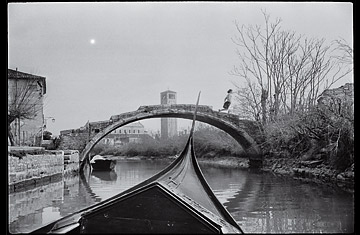
Italy. Venice. 1953. Torcello in the Venetian Lagoon.
With 300 or so photographs, "Henri Cartier-Bresson: The Modern Century," a new exhibition at the Museum of Modern Art in New York City, is, as Ed Sullivan used to say, a really big show. No doubt, nothing less would do to represent the vast scope of an artist Richard Avedon called, with just the slightest exaggeration, "the Tolstoy of photography."
But six years after his death at the magnificent age of 95, Cartier-Bresson proves that you can be one of the most famous names in photography and still be one of its greatest enigmas. For a few years in the 1930s, he was a fiercely dedicated avant-gardist, making pictures that were powerfully strange. Yet after World War II, he somehow became one of the biggest mainstream photojournalists, working for magazines that liked pictures to be plainly legible and not too subtly nuanced. And let's not even talk about inscrutable.
Born near Paris in 1908 to a prosperous family of thread manufacturers, Cartier-Bresson once hoped to become a painter. As it turned out, his gifts in that department were modest; no less a judge than Gertrude Stein took one look at his work and suggested he join the family business. Wealthy enough to do nothing in particular, he drifted for years, studying with the middling painter André Lhote and hanging on the edges of the Surrealist movement. Though his formal education ended at 18, he was a classic aesthete, bookish and art-obsessed, with fine-boned features and skin so fair that in Mexico a girlfriend gave him a Spanish nickname meaning "beautiful man with face the color of shrimp."
He was tougher than he looked. In 1930 he abruptly abandoned the stale confines of bourgeois civilization for the more primal realms of French colonial Africa. (Even in this, he was playing the artiste: think Gauguin in Polynesia or Rimbaud in Abyssinia. Among the French, the flight to primitivism was something of a creative-class tradition.) In the Ivory Coast, he lived for a year as a hunter, selling to villagers the game he killed. And without quite thinking of himself as a photographer, he also took pictures.
It wasn't until his return to France in 1931 that Cartier-Bresson made a crucial realization: through photography, he could achieve the goals of the Surrealists he so much admired. The MoMA show, which runs through June 28 and then travels to Chicago, San Francisco and Atlanta, is a career-spanning retrospective. But while Cartier-Bresson's Surrealist phase would be just a brief moment in that career, it was a crucial one.
MoMA's chief curator of photography, Peter Galassi, who organized this show, produced a brilliant little Cartier-Bresson exhibition in 1987 that made explicit the importance of Surrealism to the photographer's early work. Cartier-Bresson never joined the movement in any formal way and didn't even care much for the work of Surrealist painters like Salvador Dalí and René Magritte, who he thought simply illustrated contrived paradoxes. What excited him was the Surrealist attempt to bypass the rational faculties as a way to glimpse a deeper reality. In their struggle to circumvent the conscious mind, the Surrealists tried hypnotism, free drawing and automatic writing. It was Cartier-Bresson's great insight that his Leica was the most automatic instrument of all. If a photographer simply gave himself over to the chance encounters of the day and captured them at the right instant, a snapshot could drive straight to the heart of the uncanny. All the obsessions of Surrealist fantasy — shock juxtapositions, erotic concealments, dismembered anatomies — were at large in the ordinary life of the streets.
As his biographer Pierre Assouline once put it, in those years Cartier-Bresson used his camera "as a Geiger counter," a machine to register the secret pulse of the world. And there's certainly a whole world of crackling enigmas in Valencia, Spain, 1933, made at a bullring. On the right, a man's disembodied head signals to us from his frame within a frame. At center, a broken 7 presides in a semicircle that seems to emanate from his glasses. And at left, another man peers into a dark threshold. All it took to find these things was a click.
